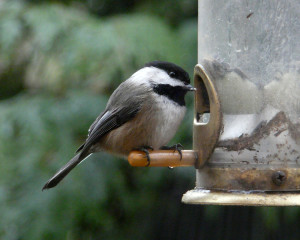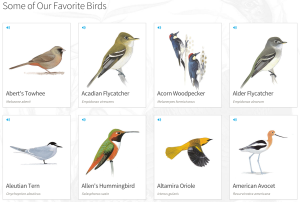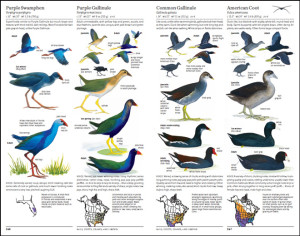Put down your trowel.
Bird watching has beat out gardening as the fastest growing hobby in the US and Canada. A recent study in Canada revealed that 1 in 5 people has become …. a birder! It’s hard to think of one activity that finds a child on grandma’s lap watching a chickadee at a feeder, and a booted hiker traversing a canyon to spot nesting golden eagles.
Everyone can be a bird enthusiast.
For the backyard ornithologist and the adventurous eco-traveler, there are two things a birder needs in their kit. The first is a good set of binoculars… and the second is a good quality field guide. The most famous of these species portrait collections appeared in the 1830s. And the artist was? John James Audubon.
Audubon’s pivotal artistic avian masterpiece was set in motion during his childhood in France – when, like the rest of us, he became enchanted by the allure of birds. Audubon’s Birds of America is the product of a tenacious and dedicated ornithological genius. But are paintings more complicated to “read” than photographs?
Why photos may be the best choice
If you have ever purchased a painted field guide, you already know how difficult it can be to read those pictures. Printing processes alter the colors of the original paintings – making the accuracy issue even worse. When you have similarly marked species (is it a female house sparrow or a white–throated sparrow… a Wilson’s Warbler or a Yellowthroat?), the clarity of photography ensures quick and easy identification. Pack the photo guide and leave the paintings for your home décor! There are some hybrid photo/artwork selections that blend the best aspects of both illustration methods and these are listed in the last section.
What are field guides?
Field guides are the go-to source for bird watchers. They provide information on species, juvenile and sex associated plumage, body posture and movement habits, habitat, behavior, song, flight patterns and feeding styles. That is quite a bit, but all this information is necessary to help an observer deduce, usually through the process of elimination, what feathered beauty is in front of them.
Online versions for homework
Online bird identification guides are perfect for getting a thorough understanding of the species in your area. These websites have photos and video, song recordings and behavior pointers to help you develop a knowledge base. They also have great links for you to get more birding information. The song sections are worth studying as bird watching is mostly about bird listening!
Here are a few resources from top ornithological sites:
Audubon
The Cornell Lab of Ornithology
The American Birding Association
How to use your guide
Break down the identification steps by moving from generic to specific. Take note of the size and silhouette (outline) of the bird. The video below explains this process extremely well.
A wren has the size and plumage color of a sparrow but has a very different “perky” silhouette. Field guides that categorize their book’s sections by family are the best choice for beginner birders and for quick researching in the field. You won’t find a Painted Bunting in Vermont or a Least Sandpiper in Kentucky.
If you plan to bird watch in a specific location, purchase a local guide. Peterson prints editions geared to regions. Check out their birds of western and eastern North American selections. Visit or contact your local bird societies or wild bird supply stores. These resources will have a wide selection of guides to search through. Find books that cater to individual families, species or habitats:
http://www.birderslibrary.com/features/shorebird-guide-comparison.htm
https://www.audubon.org/news/review-crossley-id-guide-raptors
http://blog.aba.org/2014/07/understanding-rarity-rare-birds-howell.html
Where to buy
Home and garden centers have bird supply sections. Often these stores carry a selection of bird watching books. Contact bird watching clubs or larger organizations (Audubon has local chapters and shops), including your neighboring university, to decide which guide works best for your birding needs. You can also purchase guides online. The newer editions are often of higher picture quality and have been updated with new research as well. There is a bird book for every budget.
Mobile birding
Check out the new apps available for your cell – talk about mobile bird watching! Lighter than any text and available at the tip of your fingers – you have photos, depictions…and real vocalizations to compare. You can even play these calls while in the field to attract those species. This gives “tweeting” a fresh interpretation – you can have fun with a whole new kind of cross-species social media as you chat with these peeps!
Try these apps:
https://itunes.apple.com/us/app/chirp!-bird-song-usa-+/id364891918?mt=8
https://itunes.apple.com/us/app/birdseye-bird-finding-guide/id324168850?mt=8&ign-mpt=uo%3D6
https://itunes.apple.com/us/app/audubon-birds-pro/id333227386?mt=8
https://itunes.apple.com/us/app/national-geographic-birds/id315268465?mt=8
Recommended Field Guides for Bird Watchers
The Sibley Guide to Birds (2nd edition): Yes, this one has paintings, but this guide contains many useful sections including, habitat maps including rare sighting areas and normal ranges, phonetic descriptions of calls, migration patterns, migratory species, taxonomic order and common name search terms. David Sibley’s masterful illustrations have been digitally reproduced eliminating much of the earlier accuracy issues. This New York Times bestseller has been purchased by millions of birders – they can’t be wrong! Some readers have commented on the small print, but this book contains a vast amount of pertinent tips for the majority of serious bird watchers – and the price is in the budget range. Combine a rich publication such as Sibley’s with a photo illustrated guide.
The Stokes Field Guide to the Birds of North America: Stokes is an old standby. This field resource is illustrated with photographs – making quick and accurate live observation simple and easy. Birds don’t hang around or come into clear view for identification, so we are often left with fleeting glimpses. Figuring out what popped into view is simpler with clean photographs and explanations of song, flight and behavior antics. New editions come with a CD recording of bird songs, 853 species represented and over 3,000 photographs. Copies can be grabbed for under $25 – this guide is a bargain.
Kaufman Field Guide to Birds of North America: If you want a handy book to cart into nature with you – this is the one. Designed and organized for use in the field – the birds are arranged by family rather than taxonomy – a big help when you need to identify a bird by size, shape and silhouette. Range and migration maps face the page with the bird’s depiction- making range elimination or inclusion easy. The addition of a tab feature allows instant navigation through the various possibilities, from wading birds to warblers. Renowned naturalist and conservationist, Ken Kaufman, has combined the clarity of photography with the markings enhancement of illustration in his groundbreaking guide. Purchase the new editions with current findings by the American Ornithology Union, updated species lists and range maps.
Try these as well – National Geographic Field Guide to the Birds of North America for handy use while in the field, and the Tory Peterson guides, oldies (the first edition was printed in 1934) and still goodies.
Well, those birds aren’t waiting! Drop us some more tips and suggestions for getting the most out of this fantastic past time.



